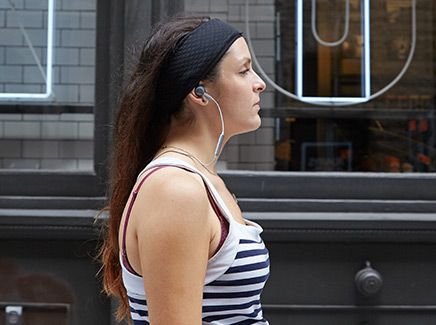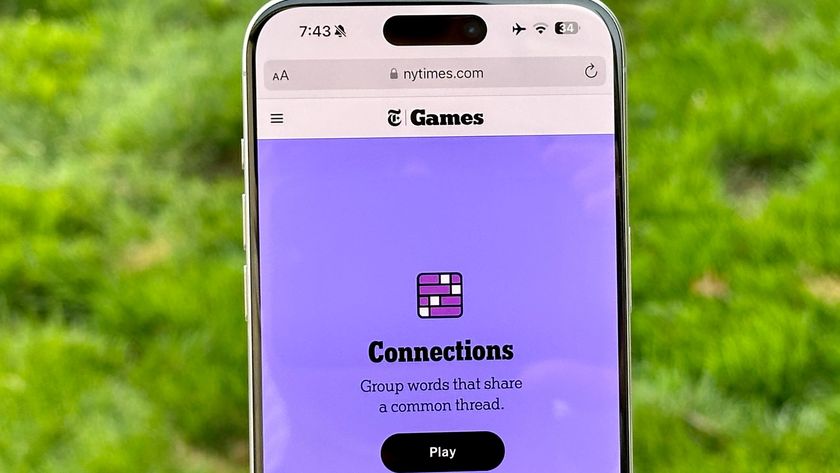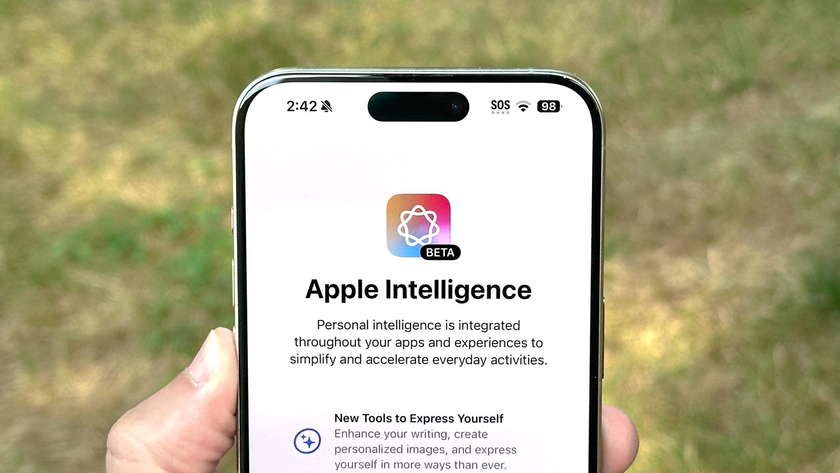Tom's Guide Verdict
The $149 Jabra Sport Coach wireless earbuds provide great sound quality, a comfortable design and easy-to-follow workout guides to help shake up your exercise routine.
Pros
- +
Comfortable, secure fit
- +
Good overall sound quality
- +
Easy-to-follow, guided workouts
Cons
- -
Short battery life
- -
Not as loud as other sports earbuds
Why you can trust Tom's Guide
One of the hardest parts of working out is finding the right variety, but Jabra is tackling this with the Sport Coach wireless earbuds. Utilizing the Jabra Sport app, these $149 earbuds contain an audible CrossFit coach that guides you through different workouts. While we wish their battery life were better, the Sport Coach headphones offer good sound quality and do a great job of being that butt-kicking voice inside your head.
Getting Started
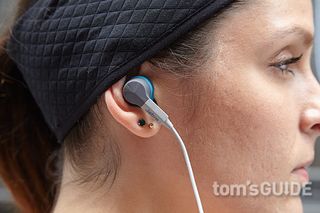
I first put on the Jabra Sport Coach headphones at a training session in New York City. Like the heart-rate-monitoring $165 Jabra Sport Pulse, they're a bit bulky; one side houses the micro-USB charging port, and the other hides the TrackFit motion sensor. The latter is used to discreetly track your distance, pace, steps, cadence and calories burned during workouts.
However, bulky isn't a bad thing. The large bud backs, which resemble miniature versions of astronaut helmets, filled out the crevices on my ears well. I made sure to pick the largest ear inserts that came with the device (you get three sizes of both the ear inserts and the ear wings), and I stuck with the medium-sized wings.
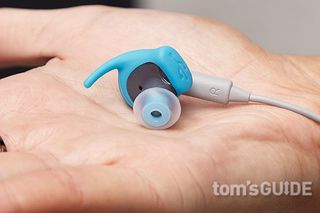
The thin, rounded wire that connects the two buds is comfortably long, letting me drape the earbuds over the back of my neck while I waited for the workout to begin. On the wire, close to the right bud, is the in-line remote with a multifunction button and a volume rocker that lets you control song playback.
My review unit came in blue with gray wires, but you can also get the Sport Coach in red or yellow. The earbuds are IP55 rated, meaning they can withstand dust and splashes of water.
The First Workout
Setting up the Sport Coach was simple; I just had to press and hold the multifunction button with the earbuds off to enter pairing mode. I opened the Bluetooth settings on my iPhone 6, and the Sport Coach popped up immediately under Available Devices. Once connected, I opened the Jabra Sport app, and my device showed up on the home screen, displaying its battery life and my current cadence measurement.

Then, a professional trainer guided a group of us through the first workout in person. Tapping on the Workout section of the app opens a list of preset exercise routines you can choose from and modify if you wish. When we selected CardioCore, we saw a breakdown of exactly what moves constitute the workout. In this case, we were about to take on 4 intense minutes filled with high knee jumps, squats, butt kickers, crunches and more.
I wasn't as familiar with "butt kickers" as I should have been, but tapping on the move brings up a small drawing and description of the exercise ("Run on the spot and ensure your heels touch your buttocks with each step.") These description pages helped me immensely later on as I explored other workouts with foreign moves.

Before I knew it, the app was counting down from 10 to start the CardioCore workout. As soon as the countdown was over, a British, female voice told me to run with my knees high for 30 seconds. In between panting, I glanced down at the app: A timer was counting me down from 30 seconds, and the female voice — let's call her Monica — told me when I had just 5 seconds left.
After a 10-second rest, I was told to do 20 squats. Instead of a timer telling me when I was finished, I had to manually press a check-mark button on the app when I finished the task. The app continued this way the rest of the workout; some reps were measured in seconds, and some were left up to me and my honesty to mark as completed.
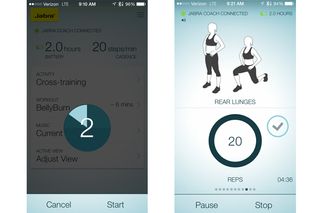
As soon as the 4 minutes were up, the trainer commanded us to do the same CardioCore routine again while I tried to catch my breath. While experiencing slight distress, I booted up the workout again on my app and was counted down: 10, 9, 8....
I work out regularly, but I've never done cross training, and this was intense. There are short bursts of movement, even shorter rests in between and quick transitions amidst it all. After that CardioCore routine, we did one set of MadCore, another preset workout that was similar but also incorporated frog jumps, kettlebell swings and burpees. I was drenched in sweat and begging for water by the time we finished all the routines.
But I felt good! I felt better than I usually do after my regular workouts, and it's because the app pushed me out of my comfort zone. And it did so without requiring me to use much more than my normal workout gear: my smartphone and headphones. The only extra piece of equipment I used was a kettle bell, which is easy for me to find at my gym.
MORE: Best Workout Apps for iOS and Android
Throughout the whole workout, my music was playing in the background, too. From the app's home page, you can select where you get your music from: iTunes Music, Jabra Sound or Current Active, the latter of which streams your last open music app (for me, that's Spotify). When Monica ordered me around, the music lowered but never fully turned off, which I appreciated.
The Second Workout
It was 6 a.m., and my thighs throbbed. Feeling like a vice grip was squeezing the life out of the top part of my legs, I knew I had pushed myself more in that workout than normal. But being sore is proof you had a great workout, or at least that's what I told myself as I waddled to my gym.

I tried two new workout routines: BellyBurn and PushPerfect, both of which target your core. My goal in changing up my usual workouts is to strengthen and tone, not necessarily lose weight, and these two routines did a good job of focusing on my midsection with planks, crunches, push-ups and wall sits.
Throughout it all, the Jabra signature sound quality shined through. All of the songs on my Dance Workout playlist, including Fifth Harmony's "Worth It" and Stromae's "Alors on Danse" came through fast-paced and full of energy.
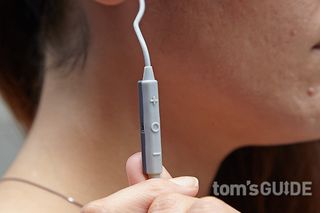
Dustin Lynch's "Where It's At" was light and airy, boosting my mood in the middle of a difficult set, with electric guitars twanging in the background and Lynch's definitively deep, throaty voice rising above everything in the track.
Maroon 5's chant "This Summer" had a bass line that reverberated in the background of the tracker, although the bass could have been louder. However, I could clearly hear the soft rainmakers that would normally be drowned out by the overwhelming bass on the $199 Beats Powerbeats2.
Overall, the sound quality from the Sport Coach was nearly identical to that of the Jabra Sport Pulse, and the buds performed better than the $149 SMS Audio BioSport earbuds across different music genres. The only gripe I had with the Sport Coach's sound was that it didn't get as loud as the Powerbeats2 did, even though the buds' design helped keep any ambient noise out of my head while I worked out.
Going Forward
After going through all but one of the preset routines, I knew my ideal workout would be 75 percent BellyBurn/PushPerfect-like and 25 percent CardioCore/MadCore-like. So I made my own workout by tapping the plus sign icon at the top right corner of the app in the Workout page. Here, you can name your workout and add any of the 56 exercises to it to create your routine.
After trying out most of the installed routines to get a feel of what I liked best, making my own workout really helped me personalize my training. There are even exercises like treadmill run or CrossFit machine (which looks like an elliptical in the diagram) that you can add to your personalized routines. This allows you to create lengthy workouts combining sessions of cardio mixed with short bursts of high-intensity moves.
MORE: Best Headphones and Earbuds for Enjoying Music
While the motion sensor in the Jabra Sport Coach provides insightful information, I didn't get much use out of it in the gym. I probably would have found the coach more useful if I were running outdoors, using it in conjunction with the GPS on my iPhone 6.
I would have loved a heart rate monitor in the earbuds as well, but it would have to be more accurate than that of the Jabra Sport Pulse. If you want to train using heart rate zones, you're better off with the SMS Audio BioSport earbuds, which have a more accurate monitor.
Battery Life
After 4 hours of active use across four days (three workouts and two work commutes), the earbuds had 1.5 hours of battery life left. That's in line with the 5.5 hours of battery life Jabra promises on the Sport Coach, and similar to the 5 hours that the Jabra Sport Pulse delivers. However, the Beats Powerbeats2 will survive for 6 hours on a charge, and the SMS Audio BioSport earbuds don't even need charging at all.
Bottom Line
Those who want exercise-ready wireless earbuds need look no further than the Jabra Sport Coach. These buds provide solid audio quality perfect for in-the-gym and on-the-go listening, and they make it easy to spice up your exercise routine.
Anyone who's looking for new workouts will love the guided routines of the Jabra Sport app, and how easy it is to follow them simply by listening. Ideally, I would like a little more battery life, but the $149 Jabra Sport Coach headphones are still the most exciting and satisfying sport earbuds I've tried.
Valentina is Commerce Editor at Engadget and has covered consumer electronics for a number of publications including Tom's Guide, Wired, Laptop Mag and Ars Technica, with a particular focus on wearables, PCs and other mobile tech.
